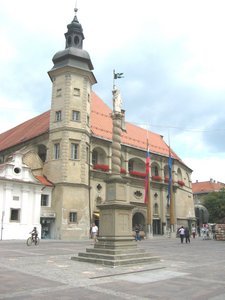Advertisement
Published: October 18th 2009

 MARIBOR CASTLE/ST.FLORIAN
MARIBOR CASTLE/ST.FLORIAN
14TH CENTURY CASTLE AND STATUE IN TOWN CENTER SQUARE( Excerpt from my book: OUR SUMMER IN SLOVENIA, AMAZON.COM)
Leaving our comfortable guest house nearby Celje after a satisfying breakfast, except for the instant coffee, we set off for Maribor, Slovenia’s second largest city (about 110,000.) The morning coffee, very important to starting Elysee’s day, as it is for many Americans including myself, was the nasty European Nescafe type. This loathsome brew, common throughout Europe, thankfully is becoming less popular. It is a sour-tasting imitation of coffee, sure to start your day with a frown and an acidic stomach. We promised ourselves that the first thing we would do in Maribor would be to search out a civilized cup of coffee.
Arriving in the old quarter of the city situated alongside the Drava River, we parked quickly and strode towards the old square. The square features a statue of St. Florian and also is the site of Maribor castle, begun in the 14th century and for once not built on a hilltop. Maribor, like many towns at the time, financed its growth and development from a large Jewish community and grew wealthy on timber, wine and the port developed on the Drava river. As happened throughout Europe in

 RABBI ABRAHAMS TOMBSTONE
RABBI ABRAHAMS TOMBSTONE
DATED 1379 AT THE MARIBOR MUSEUMthe later part of the 15th century, exemplified mostly by Spain with the Jewish expulsion in the 1490s, the Jewish community was also expelled from Maribor during the same period. The town thereafter competed with similar river locales for the commercial lead in Eastern Slovenia, but gained a leap ahead with the arrival of the railroad in 1846. Maribor became the first town in Slovenia to have a direct rail link to the imperial capital in Vienna, and developed as a major stopover on the line between Budapest, Vienna and Trieste. In the age of railroads, gaining this important position on the main line was critical, and Maribor increased in importance as other competing cities declined.
Aside from the fact that Maribor is home to Slovenia’s second university, the city offers only two particularly interesting features for a half-day stopover. First, as the region is a major Slovenian wine-producing region there are many opportunities to taste and purchase the vintages. There is a nest of underground wine cellars covering a vast area that can store seven million liters of wine. The 160-year-old cellars are filled with oak barrels, that are kept at a constant naturally arrived at 15c. Secondly,

 TITOS UNIFORM
TITOS UNIFORM
WORN BY THE INVISIBLE MAN ALSO AT THE MARIBOR MUSEUMand where we spent most of the day, is the Maribor museum housed in the former castle, just opposite the iconic statue of St. Florian that dominates the center square. The museum, establish in 1903, contains some of the richest collections of “Sloveniana,” organized into historical, commercial, cultural and ethnographic displays. It has a collection of military uniforms from the 18th century onwards, culminating with a display of Marshal Tito’s uniform. Accompanying this are displays of period dress, mostly of the Austrian bourgeoisies. Also, an extensive collection of Romantic, Baroque and Rococo art, routinely religious and church carvings (you really have to like this stuff, which I do not), and a loggia that contains tombstones from the Jewish era in the 14th century. Altogether a very nicely displayed collection and well worth a visit if you just happen to be in Northeastern Slovenia. As an aside, it is interesting to note that our visit occurred on a Friday and the beginning of the European “I quit work for the month of August”, and yet we were the only people in the museum. I was left with the impression that the Maribors don’t really care much for all this. After all it was mostly Austrian history and culture, not Slovenian.
A final note: Maribor, being an important manufacturing city for Germany in WWII, was extensively bomb-damaged from allied air-raids. Almost two thirds of the city was lost. After the war the city was a center for Yugoslavian industry, and it now has many “SocialRealistic” housing developments of a singularly unappealing appearance. You can sense the socialist past today in the quietness of the people and the remaining vestiges of run-down infrastructure; but, times are changing.
Advertisement
Tot: 0.419s; Tpl: 0.009s; cc: 8; qc: 44; dbt: 0.1573s; 1; m:domysql w:travelblog (10.17.0.13); sld: 1;
; mem: 1.1mb

 MARIBOR CASTLE/ST.FLORIAN
MARIBOR CASTLE/ST.FLORIAN
 RABBI ABRAHAMS TOMBSTONE
RABBI ABRAHAMS TOMBSTONE
 TITOS UNIFORM
TITOS UNIFORM